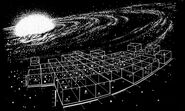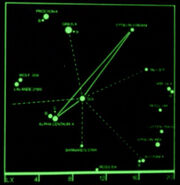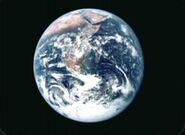AT: "xx"
- "Earth? Never heard of it."
- - various species encountered by the crew of Enterprise (NX-01)
Earth (or Sol III or Terra) is the inhabited third planet of the Sol system. It is a M-class planet and has a single natural satellite, Luna. Earth is the homeworld of the Humans and the Voth, amongst others, and is the capital planet of the United Federation of Planets.
In 2150, with the last nation-states joining, the planet was unified under the United Earth government. It was a founding member of the Coalition of Planets in 2155, and of the United Federation of Planets in 2161. The President's office, the Federation Council, as well as Starfleet Headquarters and the main branch of Starfleet Academy were located on Earth. During the Dominion War, Earth's strategic importance was on par with worlds like Andor, Berengaria VII, and Vulcan. (Star Trek: The Motion Picture, Star Trek IV: The Voyage Home, Star Trek VI: The Undiscovered Country, TNG: "Conspiracy", "The Best of Both Worlds", DS9: "Homefront", "Paradise Lost", "In the Cards", VOY: "In the Flesh", ENT: "Broken Bow", "Zero Hour", "Home")
Planetary Data
Earth is a spheroid-shaped planet with a circumference of 24,874 miles (40,075 kilometers), a mass of 5.8×1024 kilograms and a mean density of 5.517. Its atmosphere has an average temperature of 75 °F (24 ºC) and consists of 78% nitrogen, 21% oxygen as well as smaller percentages of krypton, neon, and argon. (TOS: "Miri", "Metamorphosis", "Bread and Circuses")
Astronomical data
Location

A map of Earth in the 24th century
The location and orbit of Earth inside the Sol system is depicted on several ancient and modern planetary system charts (Star Trek: Enterprise opening titles; TOS: "The Cage", "The Changeling") and the location of the Sol system in relation to other stars in the galaxy is depicted on several star charts. (Star Trek II: The Wrath of Khan; Star Trek VI: The Undiscovered Country; TNG: "Conspiracy")
Template:SolSystem
History
- See also: Human history, Federation history, List of Earth conflicts
Earth as it appeared about 3.5 billion years ago
The first life was formed on Earth from a group of amino acids that combined to form the first proteins approximately 3.5 billion years ago. From this humble start, at least three known corporeal sentient species evolved on Earth, Human, Voth, and Humpback whales. The first two species shared the basic humanoid appearance, which may be the result of the genetic seeding that occurred long ago by the first sentient species to inhabit the galaxy. Tens of millions of years prior to the development of modern man, the Voth society abandoned the Earth, thrusting itself towards the stars, leaving no apparent trace on Earth of their civilization that existed. (Star Trek IV: The Voyage Home; TNG: "The Chase", "All Good Things..."; VOY: "Distant Origin")
Earth is the birthplace of several major religions, such as Buddhism, Christianity, Hinduism, and Judaism. Some of these religions, in one form or the other, have survived into the 23rd and 24th century. (TOS: "Balance of Terror", DS9: "Penumbra", VOY: "The Killing Game")
In the 17th century, the scientist Galileo Galilei taught the masses that the Earth moved around the sun, building on the prior theories of Nicolaus Copernicus. For these teachings, he was tried and convicted of heresy by an inquisition, and his books were burned. (DS9: "In the Hands of the Prophets")
Earth has also been visited, observed, and occasionally manipulated during its history, prior to official First Contact by the Vulcans. One of the earliest extraterrestrial visits was by a race known as the Sky Spirits, originally native to the Delta Quadrant. These also included an ancient humanoid species, the Preservers, descendants of Humans abducted around 4000 BC, and Vulcans themselves, although there is still dispute about this as there was no proof or evidence offered by the Vulcan High Command. The Humpback whales were being observed by an unknown entity, who upon loss of contact with the species, sent a probe to investigate the absence of whale song. In the 19th century, a race called the Skagarans abducted several thousand Humans from the American west and then used them as slave labor. The El-Aurian Guinan also stayed discreetly on Earth. In the 1930s the Briori visited Earth and abducted several individuals, including famous pilot Amelia Earhart. In the 1950s a team of Vulcan explorers were temporarily stranded on Earth. (TOS: "Assignment: Earth", "The Paradise Syndrome"; Star Trek IV: The Voyage Home; TNG: "The Chase"; TNG: "Time's Arrow"; ENT: "Carbon Creek"; VOY: "The 37's"; VOY: "Tattoo")
From the mid-20th century onwards, manned and unmanned spacecraft were launched from either the surface or the orbit of Earth. Several prominent craft that have been launched from Earth include Apollo 11, Nomad, Phoenix, Friendship 1, Enterprise, and the USS Enterprise, (TOS: "The Cage", "Where No Man Has Gone Before", "The Changeling"; Star Trek: First Contact; VOY: "Friendship One"} Beginning in the 22nd century and continuing into the 24th, there were major construction projects on the surface and in the orbit of Earth that supported the burgeoning expansion of Humans into space. Some of these projects were the Warp Five Complex, the San Francisco Fleet Yards, Spacedock, and Earth Station McKinley. (ENT: "Broken Bow"; TOS: "Where No Man Has Gone Before"; Star Trek III: The Search for Spock; TNG: "Family")
In 2063, with the successful flight of the Phoenix, Humans became warp capable. (Star Trek: First Contact)
According to Daniels, while Earth still exists in the 31st century, it does not exist in the same way as it was defined 900 years before. (ENT: "Cold Front")
Attacks on Earth
During its long history, the existence of the planet has been threatened by both natural disasters and the actions of alien intelligences.
- In 2153, Earth was preemptively attacked by the Xindi, who were unwittingly helping a faction fighting the Temporal Cold War. Using a smaller prototype version of the planned Xindi superweapon, the weapon destroyed a section of the planet stretching from Florida to Venezuela, killing seven million people. This event began what was later known as the Xindi crisis. (ENT: "The Expanse")
- On February 14th of 2154, a working version of the Xindi superweapon entered Earth orbit to destroy the planet. The weapon was destroyed by Captain Jonathan Archer before it could complete its task. This marked the end of the Xindi crisis. (ENT: "Zero Hour")
- In 2155, Terra Prime, under the command of John Frederick Paxton, used the verteron array on Mars to attack Starfleet Headquarters. Thanks to the efforts of Commander Charles Tucker III, the array fired harmlessly into the San Francisco Bay. (ENT: "Terra Prime")
- In 2273, a massive machine lifeform called V'Ger threatened to destroy all biological life on Earth if its demands were not met. The attack was narrowly averted by the crew of the USS Enterprise. (Star Trek: The Motion Picture)
- In 2286, a alien probe of unknown origin wreaked ecological havoc while trying to contact an extinct species of Humpback whale, by transmitting massive amounts of energy into Earth's oceans and unintentionally caused them to begin evaporating. The threat was ended when the former crew of the USS Enterprise, having used a stolen Klingon Bird-of-Prey to travel back in time to before the species' extinction, returned to the present with two Humpbacks, and after the two whales gave a response to the probe, it departed the Solar System with little, if any, real harm done to the planet. (Star Trek IV: The Voyage Home)
- In 2367, a Borg cube entered Earth orbit following the Battle of Wolf 359 with the intention of assimilating the planet and its population. It was destroyed by the USS Enterprise-D before it could attack the planet. (TNG: "The Best of Both Worlds, Part II")
- In 2373, a second Borg cube attacked Earth, and after a devastating battle was destroyed in orbit by a Starfleet armada. As the cube exploded, a Borg sphere escaped from within the craft and subsequently traveled into the past, where its complement of Borg drones attempted to prevent Humanity's First Contact with Vulcans in 2063. (Star Trek: First Contact)
- In 2375, the Borg decided to create another strategy, since all direct assaults on Earth had failed thus far. They planned to detonate a biogenic charge in Earth's atmosphere, infecting all lifeforms with nanoprobe viruses, triggering a gradual assimilation. According to the Borg Queen, half the population would be become drones before the effects were discovered. (VOY: "Dark Frontier")
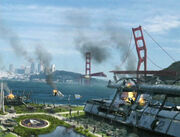
Starfleet Headquarters on Earth, damaged after a Breen attack
- Also in 2375, the Breen Confederacy attacked Earth in a surprise attack on Starfleet Headquarters in San Francisco during the Dominion War. (DS9: "The Changing Face of Evil")
- In 2379, Praetor Shinzon attempted to destroy all life on Earth using a thalaron weapon built into the Reman warbird Scimitar. The Scimitar was destroyed by the USS Enterprise-E, IRW Valdore, and an unidentified Template:ShipType warbird in the Battle of the Bassen Rift. (Star Trek Nemesis)
Climate and geography
From at least the dawn of Humans, Earth has been a Class M world by 23rd century planetary classification standards. Earth has several major landmasses and a wide variety of climatic and surface conditions, ranging from tundra to desert. By the 24th century, Humans had installed a weather modification network to alter the natural weather patterns of Earth, including dissipating destructive weather phenomena such as tornadoes. (TNG: "True Q")
Land features, geographical markers, and formations
- Alps
- Caspian Sea
- El Capitan
- International Date Line
- Mount Cook
- Mount Everest
- Mount McKinley
- North Pole
- Pacific Ocean
- Tibetan plateau
- Tropic of Cancer
- Ural Mountains
- Yosemite National Park
See also: Geopolitical Regions (Countries and States), Cities and Towns
| Continents of Earth |
|---|
| Africa • Antarctica • Asia • Australia • Europe • North America • South America |
In Art
Once Humans began leaving Earth in the 20th century, they photographed and drew pictures of the planet for various reasons. These pictures were then displayed in homes, offices, and recreation facilities. The earliest depictions of Earth were from the space agencies which sent Humans into space. These included official mission photos and insignias. Many of these images were preserved into the 22nd century and beyond. (TOS: "The Cage", ENT: "First Flight"}
Human-created points of interest
Parallel universes and alternate timelines
Alternate timelines
Earth devastated
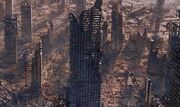
Earth devastated in the 31st century
Earth was devastated in several alternate timelines. Accidental time travel from 2371 led to the premature death of Gabriel Bell in 2024, creating an altered future where the more inhumane wars of the 21st century left Humans a pre-warp civilization that never even expanded to the solar system. (DS9: "Past Tense, Part I", "Past Tense, Part II")
When the temporal agent Daniels was instructed to remove Jonathan Archer from the timeline in 2152 and bring him to the 31st century, an alternate future was created where the United Federation of Planets was never formed and Earth was almost completely destroyed. (ENT: "Shockwave", "Shockwave, Part II")
In 2370, a new past was created for Earth by the anti-time eruption, where 3.5 billion years ago amino acids never combined with the first proteins, and thus life never formed on the planet. This was how the Q Continuum fulfilled its judgment to deny Humans their existence. (TNG: "All Good Things...")
Nazi-Earth
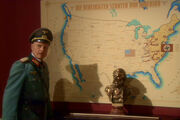
Nazi Territory in North America
In two alternate timelines, the history of Earth was significantly altered when Nazi Germany was not defeated in World War II. In one, Doctor McCoy saved the life of Edith Keeler in 1930. Keeler went on to form a massive pacifist movement in America, delaying the country's entry into World War II, allowing Nazi Germany time to develop the A-bomb first and take over the world. (TOS: "The City on the Edge of Forever")
In another alternate timeline, Lenin was assassinated in 1916, preventing Russia from turning to communism. This allowed Hitler to concentrate his war effort on the West. With assistance from the Na'kuhl, France and England were conquered before the American East Coast by 1944. (ENT: "Storm Front", "Storm Front, Part II")
Borg-Earth

Borg-assimilated Earth
In an alternate timeline, the Borg were successful at preventing First Contact in 2063 and assimilated the Earth. In 2373, the assimilated Earth had an atmosphere containing high concentrations of methane, carbon monoxide, and fluorine, and had a population of approximately nine billion Borg drones. (Star Trek: First Contact)
Earth destroyed
Earth, moments before exploding
The Earth was completely destroyed in two alternate timelines. In one of the timelines, Jonathan Archer's brain was infected by interspatial parasites and Earth was destroyed by the Xindi superweapon in 2154. This timeline was erased in 2165 when the parasites were destroyed by a subspace implosion aboard Enterprise. Because the organisms existed outside normal spacetime, their elimination prevented Archer from ever being infected in the first place. (ENT: "Twilight")
In another alternate timeline, Earth and the entire solar system was destroyed by a massive temporal explosion in the 29th century. The explosion was caused by Henry Starling, when he used the stolen timeship Aeon to travel from the 20th century into the 29th century through an unstable temporal rift. (VOY: "Future's End", "Future's End, Part II")
Alternate reality

Narada firing on Earth
In the year 2258 of the alternate reality, the Romulan mining vessel Narada fired on Earth using a drill platform. Nero attempted to dig a hole to Earth's core and create a black hole using red matter to destroy the planet. Luckily, Spock was able to destroy the drill well before it could reach the planet's core. (Star Trek)
Mirror universe
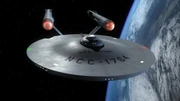
The USS Defiant in orbit of mirror Earth
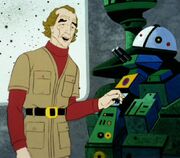
In the mirror universe, Earth's counterpart was the capital of the Terran Empire. History followed a similar yet skewed course on this Earth, by comparison to the history of Earth in the United Federation of Planets, with a more violent, war-ridden past. According to Jonathan Archer, the Empire existed "for centuries" prior to 2155. As a result of the official First Contact with the Vulcans in 2063, Earth gained interstellar technology, allowing the Empire to expand. (ENT: "In a Mirror, Darkly")
The Klingon-Cardassian Alliance conquered the Terran Empire sometime before 2370. (DS9: "Crossover")
Professor Jennifer Sisko had an image of Earth on a uniform she wore while working for the Alliance in 2371. (DS9: "Through the Looking Glass")
Reverse universe
In the reverse negative antimatter universe, where the flow of time was reversed, Arret was Earth's counterpart. In 2270, Karla Five and her son Karl Four helped the crew of the USS Enterprise to return back to the prime universe. (TAS: "The Counter-Clock Incident")
Appendices
Appearances
A list of all actual appearances of planet Earth (excluding holodecks, simulations, visions, opening credits, etc.)
- ENT:
- TOS:
- TAS:
- TOS films:
- TNG:
- TNG films:
- DS9:
- VOY:
- "Caretaker"
- "Non Sequitur"
- "Death Wish"
- "Future's End"
- "Future's End, Part II"
- "11:59"
- "Pathfinder"
- "Inside Man"
- "Endgame"
- "In the Flesh"
Related topics
- Earth animals
- Duplicate Earth
- Objects in Earth orbit
Background Information
In such episodes as TOS: "The Cage" and TAS: "How Sharper Than a Serpent's Tooth", the name Earth is used interchangeably with Sol when referring to the entire Sol system.
The star chart seen in TNG: "The Naked Now", "The Last Outpost" and "Conspiracy", which names stars within twenty light years of Sol, was drawn by Rick Sternbach for the Star Trek Spaceflight Chronology in the late 1970s. Found on page 77, this chart shows Earth commercial and exploration routes after the use of warp drive began. The Explored Galaxy star chart is first seen, chronologically, in Star Trek VI: The Undiscovered Country, set in 2293. It is also seen in several Star Trek: The Next Generation and Star Trek: Deep Space Nine episodes set in the 24th century, from the year 2364 to 2370.
According to Star Trek: Star Charts (pp. 32, 36-37, 56-57, "United Federation of Planets I"), from 2113, Earth was governed by the uniglobal United Earth government. The government of Earth was divided into six major regional powers that were governed from their respective capitals. These capitals were San Francisco (North America), Paris (Europe), Kyoto (Asia), Lima (South America), Cape Town (Africa), and Christchurch (Oceania). In 2161, Earth was a founding member of the United Federation of Planets. The dominant species were Humans and Cetaceans. Earth was a hub world on the mid-22nd century Earth trade routes. It traded with Alpha Centauri, Altair, Andoria, Denobula Triaxa, Draylax, Ophicus Colony, Tellar Prime, Trill, Vega Colony, and Vulcan. In 2378, Earth was a hub world on the major space lanes. In the census of 2370, there were 4.2 billion Humans and 8.1 million Cetaceans living on Earth. Points of interest included the UFP Council Chambers, Starfleet Headquarters, Starfleet Academy, Cochrane Memorial, Yosemite Valley, and Angel Falls.
Borg-Earth info
At a very early stage of Star Trek: First Contact's development, the film's writers – including Brannon Braga and Ronald D. Moore (as well as possibly Rick Berman) – discussed the possibility of beginning the film in a Borg-assimilated city on Earth. (audio commentary, Star Trek: First Contact (Special Edition) DVD/Blu-ray)
In its assimilated state as shown in the movie, Earth was represented with CGI done by Alex Jaeger. (Star Trek: The Next Generation Sketchbook: The Movies, p. 335) He depicted the heavily polluted version of the planet by creating a series of digital matte paintings. (Cinefex, No. 69, pp. 113 & 117) As Jaeger had only ever worked in the model shop at Industrial Light & Magic before serving as the company's visual effects art director on First Contact, he found the challenge of creating the altered Earth slightly daunting. "They kind of tossed me into this and said, 'Oh, yeah, we're going to need a Borg Earth,' and I go, 'Oh, okay,' so I did a few early Photoshop pieces that just showed a section of the Earth. Then they said, 'Yeah, that's good, but can you just make a texture for the whole planet that we'll just use in the movie,' and I'm like, 'Uhhh, okay – I've never done that before, but sure!' So, basically what I did was, I took a texture map of the Earth – it was this gigantic Photoshop file – and started changing it around." (Star Trek: The Magazine Volume 1, Issue 23, p. 88)
Included in the assimilated Earth are details hardly visible in the actual film, such as industrial pipes spanning the oceans. (Cinefex, No. 69, p. 113) "I saturated all the ground so it was gray and I added all these sort of factory-looking sections so it looked like the ground was completely covered by cities," remembered Alex Jaeger. "Then, I painted little bridgeways across the oceans and turned the oceans brown. [First Contact Director] Jonathan Frakes kept saying, 'No, the oceans have got to be brown, like they're full of crap! Just, you know, nasty; you don't want to be there.'" (Star Trek: The Magazine Volume 1, Issue 23, p. 88) Jaeger also noted that, in addition to turning the oceans brown and making the land masses "desaturated and gray, as though they have become overrun with Borg power plants and machinery," he also turned the clouds and atmosphere yellowish-green. (Cinefex, No. 69, p. 113)
Alex Jaeger was ultimately pleased with how he created the assimilated Earth, essentially destroying the planet visibly by doing so. "It turned out fairly well [....] And to have something that I actually painted end up on screen, was kind of cool." (Star Trek: The Magazine Volume 1, Issue 23, p. 88) Brannon Braga agreed that the optical of the assimilated Earth was "very cool." (audio commentary, Star Trek: First Contact (Special Edition) DVD/Blu-ray)
Apocrypha
- According to Gene Roddenberry's novelization of Star Trek: The Motion Picture, there is a dam across the Straits of Gibraltar. This allowed the level of the Mediterranean Sea to be lowered, creating new farm and park land along the coast, and the world's largest hydro-electric project.
- In the alternate future in the Deep Space Nine book series Millennium, Earth was destroyed in 2388 by the violent Grigari. Among the casualties were William T. Riker, Deanna Troi, Geordi La Forge, Beverly Crusher, Tom Paris, B'Elanna Torres, and the USS Enterprise NCC-1701-F.
- In the Star Trek: Deep Space Nine - Dominion Wars video game, if the player plays as the Dominion, the Founders destroy the Federation, bombard Earth, and then declare it to be a secondary homeworld from which to rule.

